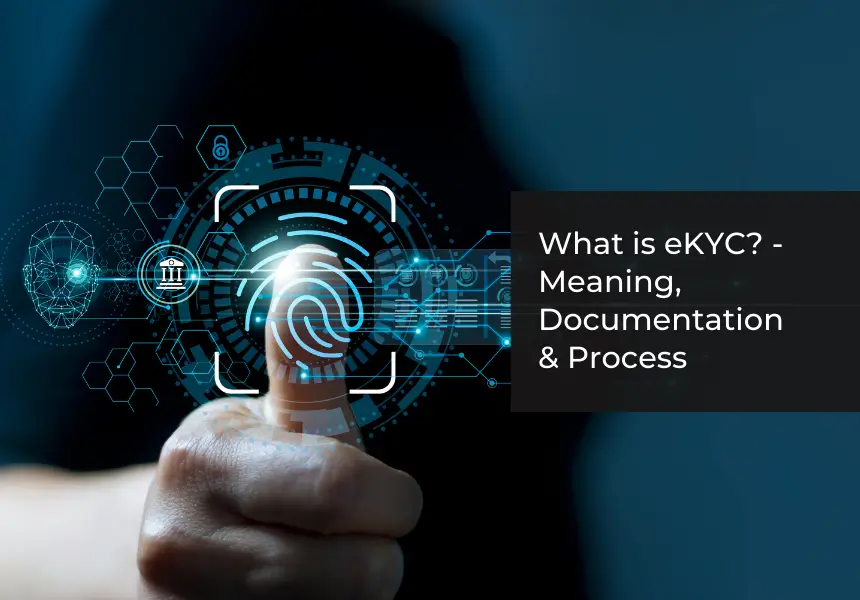
In today’s digital age, eKYC has revolutionized how lenders verify customer identities, offering a seamless and efficient solution to traditional verification methods. This section will cover the main elements of e-KYC, focusing on best practices and the essential documentation required for its implementation.
eKYC has become indispensable for various industries, from financial institutions to online service providers. It enables them to swiftly onboard customers while ensuring compliance with regulatory standards.
Understanding the documentation essentials of eKYC is vital for organizations seeking to ease their customer onboarding processes, mitigate fraud risks, and enhance overall operational efficiency.
What does eKYC mean and what does it stand for?
Using digital technology, eKYC, or Electronic Know Your Customer, transforms identification verification. It simplifies authentication by using databases and electronic documents instead of paperwork.
Businesses benefit from regulatory compliance and effective enrollment. This method enhances anti-fraud security measures and guarantees quick customer verification.
Importance of eKYC
- eKYC guarantees far more secure data verification and authentication than alternative techniques.
- An eKYC verification can only be carried out by authorized agents and companies. As a result, customers can stop worrying about their information being disclosed to unauthentic sources.
- Additionally, eKYC protects people against identity theft and similar crimes.
- This verification approach is digital and more effective than traditional manual techniques.
- There aren’t many documents needed for the eKYC procedure. All it takes to verify someone’s identification is their Aadhaar card. This speeds up and makes the verification procedure convenient.
Different Types of eKYC
Different types of eKYC methods offer varying levels of convenience, security, and regulatory compliance. Here’s an in-depth explanation of three prominent types:
OTP Based Aadhaar eKYC
OTP-based Aadhaar eKYC involves verifying the customer’s identity using their Aadhaar number and OTP is sent to the registered mobile number. The customer shares OTP with the service provider, who validates it with the UIDAI database for instant verification. Due to its speed and simplicity, this method is widely used for instant verification.
Biometric Based Aadhaar eKYC
Biometric Aadhaar eKYC involves verifying identity using stored biometric data. The customer provides an Aadhaar number and fingerprint/iris scan to the service provider, who matches it with the Aadhaar database for secure verification, ideal for finance and government agencies.
Aadhaar Paperless eKYC Offline
Aadhaar Paperless eKYC Offline involves verifying identity without the internet or biometrics. The customer’s Aadhaar XML file is securely transferred to the service provider, enabling instant verification in remote areas, prioritizing privacy and security.
Documents required for eKYC verification
Below is the list of eKYC documents required.
- Proof of Identity: Voter ID card / Aadhaar Card / Passport / Driving License / PAN Card / Identity Documents from Educational Institutions / Certified Identity Card / Employee Identity Card / Ration Card
- Proof of Address: Voter ID / Driving License / Passport / Utility Bills / Bank Account Statement / Lease Agreement / Self Declaration / House Purchase Deed / Address Proof
- Income Proof: Income Tax Return / Bank Passbook / Salary Slips (Last 3 Months)
How does the eKYC process work?
eKYC is a simple process to follow. Below is the eKYC process.
Provide Personal Information and Biometric Data
Begin by submitting your Aadhaar number and other biometric data, such as facial recognition and thumbprint, along with digital copies of documents like passports, and birth certificates. This step ensures that the system has your correct data to verify your identity and authenticate your documents accurately.
Visit the UIDAI Website
Access the UIDAI (Unique Identification Authority of India) website to initiate the verification process. Provide necessary information such as your identity, contact details, address, and other personal details. This platform is the central hub for processing and verifying the information provided, ensuring accuracy and security throughout the eKYC process.
Verify the Information
The UIDAI system cross-references the data provided with its records and databases to ensure consistency and accuracy. This verification process includes checking identity documents, contact details, addresses, and other pertinent personal information. By using a variety of sources, including government records and databases, the system ensures comprehensive verification of your identity.
Receive OTP
Upon successfully verifying your information, you will receive a One-Time Password (OTP) on your registered contact number. The OTP adds an extra level of authentication to prevent unauthorized access and ensure the integrity of the eKYC process.
Enter Captcha
Enter the OTP received on your registered contact number along with the provided captcha. This step confirms your active participation in the verification process and helps prevent automated attempts to manipulate the system. Captcha verification helps prevent fraudulent activities and ensures that only authorized individuals proceed with the eKYC process.
Complete Electronic Identity Verification (EIV)
The system automatically verifies your identity using whitelists, official sanction lists, and government records and databases. This comprehensive electronic identity verification (EIV) process confirms your identity against trusted sources, ensuring reliability and security. EIV ensures that only genuine individuals with validated identities successfully complete the eKYC process, safeguarding against identity theft and fraud.
How can I check my online eKYC status?
By visiting the KYC Registration Agency (KRA) website and following the instructions provided, you can verify your eKYC status.
- Visit the official website of Central Depository Service Limited (CDSL).
- To log in, enter your credentials. For example, to check the status of your KYC registration, you need to know your Aadhaar Card Number. To check the status, you must input your PAN if you registered using a PAN Card.
- Enter the provided CAPTCHA and click “Submit.”
- You will be able to see your current KYC verification status on the following window.
Conclusion
With eKYC, identity verification procedures have advanced significantly and are now faster, more efficient, and more secure in today’s digital environment.
Firms can effectively onboard clients through streamlined documentation and electronic authentication processes while complying with regulatory norms.
The complexity of eKYC, which includes both procedural and documentation elements, highlights its importance in several industries, including finance.
eKYC is at the forefront of consumer identification techniques as technology develops and evolves to suit the ever-changing demands of a digitally driven world. Adopting eKYC opens the door for a more secure and seamless digital environment by promoting confidence and trust among stakeholders and facilitating smoother transactions.
eKYC allows individuals to efficiently authenticate their identities and speed up the loan application process, allowing customers to access personal loans more easily and hassle-free.
FAQs
Is eKYC secure?
Ans. Yes, eKYC utilizes secure digital channels and encryption methods to protect sensitive customer information, ensuring privacy and security.
How does OTP-based eKYC work?
Ans. In OTP-based eKYC, a one-time password delivered to the customer’s registered mobile number is used to validate their identification.
How long does eKYC verification take?
Ans. eKYC verification can be completed almost instantly, depending on the service provider’s systems’ efficiency and the accuracy of the provided information.
Is eKYC legally recognized?
Ans. Yes, eKYC is legally recognized in many countries and is compliant with relevant regulatory frameworks governing identity verification.
Can eKYC be used for KYC updates?
Ans. Yes, eKYC can be used to update customer information and perform periodic reviews to ensure compliance with regulatory standards.








